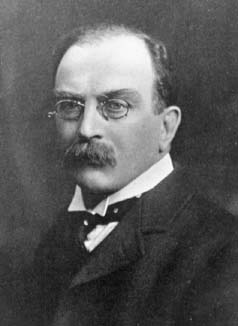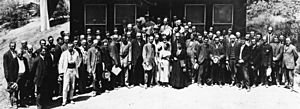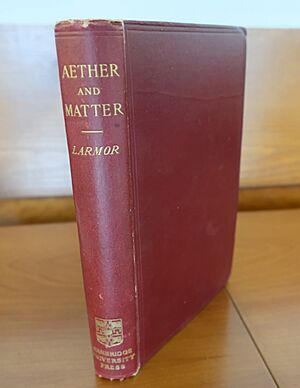Joseph Larmor facts for kids
Quick facts for kids
Joseph Larmor
FRS FRSE
|
|
|---|---|
 |
|
| Born | 11 July 1857 Magheragall, County Antrim, Ireland
|
| Died | 19 May 1942 (aged 84) |
| Alma mater | Royal Belfast Academical Institution Queen's University Belfast St John's College, Cambridge |
| Known for | Larmor precession Larmor radius Larmor's theorem Larmor formula< Relativity of simultaneity |
| Awards | Smith's Prize (1880) Senior Wrangler (1880) Fellow of the Royal Society (1892) Adams Prize (1898) Lucasian Professor of Mathematics (1903) De Morgan Medal (1914) Royal Medal (1915) Copley Medal (1921) |
| Scientific career | |
| Fields | Physics |
| Institutions | St John's College, Cambridge Queen's College, Galway |
| Academic advisors | Edward Routh |
| Doctoral students | Kwan-ichi Terazawa |
Sir Joseph Larmor (born July 11, 1857 – died May 19, 1942) was an important Irish and British scientist. He was both a physicist and a mathematician. He made big discoveries about electricity, how things move (dynamics), heat (thermodynamics), and the tiny particles called electrons. His most famous book, Aether and Matter, was published in 1900. It was a very important book in theoretical physics.
Contents
Joseph Larmor's Early Life and Education
Joseph Larmor was born in a place called Magheragall in County Antrim, Ireland. His father, Hugh Larmor, was a shopkeeper in Belfast. Around 1860, his family moved to Belfast.
School and University Studies
Joseph went to the Royal Belfast Academical Institution for his early education. Later, he studied mathematics and science at Queen's College, Belfast. He earned his first degree in 1874 and another in 1875. One of his teachers there was John Purser.
After Belfast, he went to St John's College, Cambridge in England. In 1880, he achieved a very high honor called Senior Wrangler. This meant he was the top mathematics student in his year. He also won the Smith's Prize. He finished his studies at Cambridge in 1883.
Teaching and Academic Career
Joseph Larmor taught physics for a few years at Queen's College, Galway. Then, in 1885, he became a lecturer in mathematics at Cambridge University. In 1892, he was chosen as a Fellow of the Royal Society of London. This is a very respected group of scientists. He also served as one of the society's secretaries. In 1910, he became an Honorary Fellow of the Royal Society of Edinburgh.
In 1903, Larmor was given a very special job: Lucasian Professor of Mathematics at Cambridge. This is the same position once held by Sir Isaac Newton! He kept this job until he retired in 1932. Joseph Larmor never married. In 1909, King Edward VII made him a knight, so he became "Sir Joseph Larmor."
Larmor's Time in Politics
Joseph Larmor was very against a political idea called "Home Rule for Ireland." This idea was about giving Ireland more control over its own government. Because he felt so strongly, he decided to run for a seat in the British Parliament.
In February 1911, he was elected as a Member of Parliament for Cambridge University (UK Parliament constituency). He was part of the Conservative party. He stayed in Parliament until 1922. By then, the issue of Irish Home Rule had been decided. After he retired from Cambridge in 1932, Sir Joseph Larmor moved back to County Down in Northern Ireland.
Awards and Later Life
Joseph Larmor received many honors during his life. In 1901, he got an honorary law degree from the University of Glasgow. He also won the Poncelet Prize in 1918 from the French Academy of Sciences. He was invited to speak at major international mathematics conferences in 1920, 1924, and 1928.
Sir Joseph Larmor passed away in Holywood, County Down on May 19, 1942.
Joseph Larmor's Scientific Discoveries
Larmor made many important contributions to physics. He studied the idea of the aether. This was a theoretical substance that scientists once thought filled all of space. They believed light waves traveled through it. Larmor thought the aether was a perfectly smooth and elastic fluid, separate from regular matter.
Understanding Matter and Electrons
Larmor combined his aether theory with ideas from another scientist, Lord Kelvin. He believed that matter was made of tiny particles moving within this aether. As early as 1894, he called these particles "electrons." He thought that the flow of these charged particles created electric currents.
Larmor also figured out how much energy an accelerating electron would give off as radiation. He explained why spectral lines (the specific colors of light given off by elements) split when placed in a magnetic field. This splitting happens because of the way electrons move.
In 1897, Larmor also created one of the first models of the atom that looked like a tiny solar system. In this model, electrons orbited a central part. He even suggested the existence of a "positive electron," which we now call a proton.
Sunspots and Solar Activity
In 1919, Larmor proposed an idea about sunspots. He suggested that sunspots are caused by a "self-regenerative dynamo action" on the Sun's surface. This means that the Sun's magnetic field creates currents, which in turn strengthen the magnetic field, leading to sunspots.
Larmor and the Lorentz Transformations
Joseph Larmor played a key role in developing the Lorentz transformations. These are a set of equations that describe how measurements of space and time change for objects moving at very high speeds.
In 1897, Larmor published an early version of these transformations. He showed how space and time measurements would change. He got the full Lorentz transformation equations in 1900. This was around the same time as another famous physicist, Hendrik Lorentz, and five years before Albert Einstein published his theory of special relativity.
Time Dilation and Length Contraction
Larmor also predicted the idea of time dilation. This means that time would pass more slowly for objects that are moving very fast. He wrote that orbiting electrons would complete their paths in shorter times if they were moving quickly. He also confirmed that FitzGerald–Lorentz contraction (or length contraction) should happen. This means that objects moving at high speeds would appear shorter in the direction of their motion. He explained these as dynamic effects, meaning they were caused by forces.
However, Larmor did not fully agree with Einstein's later ideas about spacetime. He still believed in an absolute aether. He also disagreed with the idea of curvature of space in general relativity. He thought that an absolute time was necessary for studying astronomy.
See also
 In Spanish: Joseph Larmor para niños
In Spanish: Joseph Larmor para niños
- History of Lorentz transformations
- Dynamo theory
- Larmor precession
- Larmor (crater)



